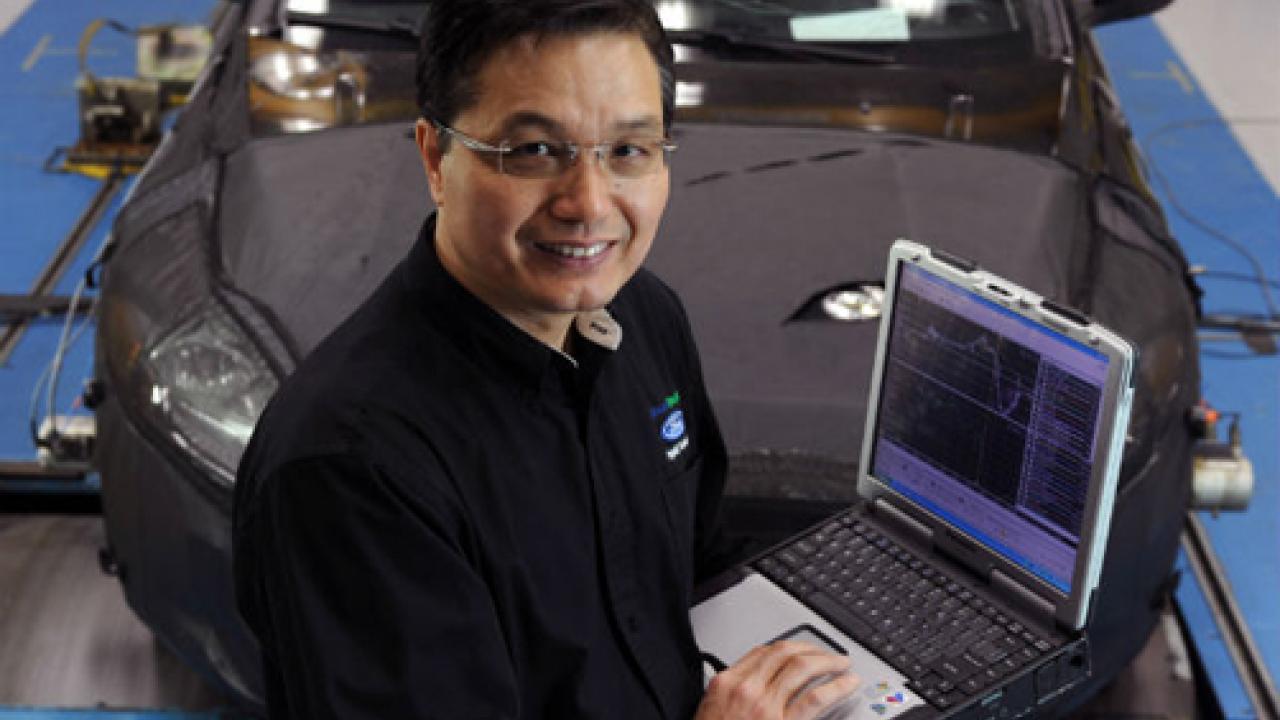Besides being the “father of the plug-in hybrid,” Professor Andy Frank is the “father” of a new generation of engineers in the hybrid vehicle field — people like Ming Kuang, who, armed with a master’s degree from UC Davis, has gone on to stardom at Ford Motor Co.
Kuang works in Ford’s Electrification Research and Advanced Engineering unit, as technical leader in vehicle controls. His name is on 40 hybrid patents, and Ford credits him with boosting the automaker’s portfolio of hybrid patents from 10 to 461 since the year 2000.
Twenty-five Kuang patents are in active production, including key components of Ford’s power-split architecture system found on vehicles like the all-new Fusion hybrid, which, according to Ford, will get 47 miles per gallon, the most for any nonrechargeable sedan in the country.
And, to think, Kuang almost never got in to UC Davis! He completed his undergraduate degree and the first two years of a master’s program at the South China University of Technology, then joined relatives in the San Francisco Bay Area in 1986, and elected to make California his home.
In 1988, he applied to UC Davis (his preferred choice) and UC Irvine. The latter accepted him immediately, but Davis turned him down.
“I called the UC Davis admissions office and told them that I really wanted to come to Davis,” he recalled during a visit to campus last Friday (Feb. 24). “I asked if I could transfer to UC Davis after a year at UC Irvine. They said they’d look into it and get back to me.
“They called back in half an hour and said that they had decided to accept me — right then — as a graduate student at UC Davis. I said OK!"
Kuang took classes with professors Dean Karnopp and Donald Margolis in the Department of Mechanical and Aerospace Engineering, then found a mentor in Frank, in the same department within the College of Engineering.
Strong social conscience
Soon, Kuang found himself evaluating the efficiency and fuel economy of an early “flywheel hybrid” that Frank had invented at the University of Wisconsin a few years before joining the UC Davis faculty in 1985.
The assignment changed Kuang’s life: He became fascinated with the concept of increased fuel economy and the challenge of energy storage, with no loss in vehicle performance.
He also developed a strong social conscience, as he recognized the positive environmental impact of such work. “It’s all about helping to make the world my children will live in — and the world their children will live in — a better place,” the father of three said.
Ford recruited Kuang to Dearborn, Mich., in 1991, soon after he completed his Master of Science degree in mechanical engineering. He began at Ford as a control engineer, working on the follow-up to the Ecostar van, Ford’s first electric vehicle.
The Ecostar, or EV-1, never went beyond an 84-vehicle pilot project. Ford (and Kuang) went further with the Ranger EV truck — putting 2,000 on the road. The trucks, model years 1998 to 2001, came out of the Ranger EV/Postal Program, with Ford selling or leasing most of the trucks to utility companies and government agencies, including the Postal Service.
Henry Ford Technology Award
About a year before the Ranger EV came out, Kuang attended Toyota’s unveiling of its Prius hybrid. “I wasn't able to drive it,” he recalled, “but I did get to sit in it!” He gave an enthusiastic report when he returned to Ford.
Toyota started selling the Prius in Japan in 1997, and the car came to the United States and the rest of the world in 2001. But Ford had not been sitting still, having assigned Kuang in 1999 to lead hybrid development.
Only half a decade later, thanks in part to Kuang's expertise in vehicle controls, Ford launched a hybrid version of the Escape, making it the first hybrid sport-utility vehicle in the United States. The SUV was named the Truck of the Year at the North American International Auto Show in 2005, while, back at Ford, Kuang received a Henry Ford Technology Award.
In his 20 years at Ford, Kuang moved from control engineer to research engineer to technical leader, contributing to a hybrid and alternate-fuel lineup that today boasts the the Escape SUV and the Fusion hybrid sedan, the Transit Connect electric van, and, still to come in 2012, the Focus electric sedan, the C-Max hybrid compact and two models (a Fusion and a C-Max) carrying Ford’s new “Energi” brand, designating plug-in hybrid.
And remember those Ranger EVs? Kuang said he was happy to see someone arrive in one to the Society of Automobile Engineers’ Hybrid Vehicle Technologies Symposium, held Feb. 21-22 in San Diego. Kuang was among the symposium’s organizers and gave a presentation on “Smart and Connected Electrification at Ford.”
Master’s thesis started it all
From San Diego he made his way to UC Davis, where he reconnected with Frank, Margolis and others, and met with Margolis’ graduate students. He also met with Enrique Lavernia, dean of the College of Engineering, and visited Assistant Professor Jae Wan Park’s Green Transportation Laboratory.
Kuang also visited Efficient Drivetrains Inc.’s Research, Development and Demonstration Center in Dixon. Frank is chief technology officer for the Palo Alto-based company.
Frank’s impact on Kuang’s career cannot be understated. In fact, according to Kuang’s biography on the Ford website, his career “could technically be traced to his master’s thesis” at UC Davis.
He had discovered, according to the biography, that the auto industry could provide him with a platform to change the world in a positive way.
“That thesis (dealing with the effect of fuel efficiency on the environment) really changed my life,” he said. “Until then, I hadn’t really considered a career in the auto business.”
Kuang has followed his mentor into academia as well, teaching at Lawrence Technological University in Southfield, Mich., and authoring or co-authoring 36 technical papers.
Media Resources
Dave Jones, Dateline, 530-752-6556, dljones@ucdavis.edu
